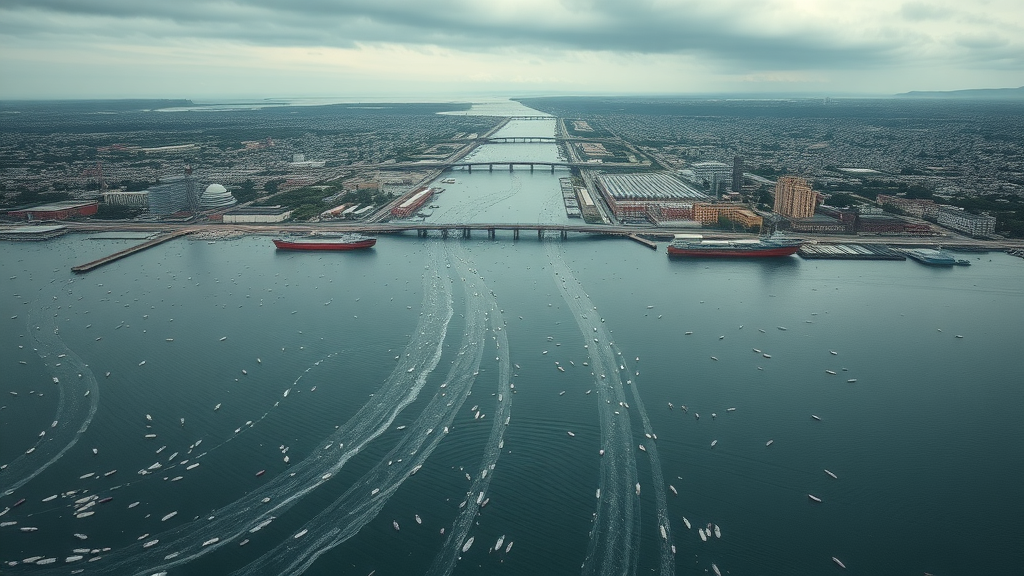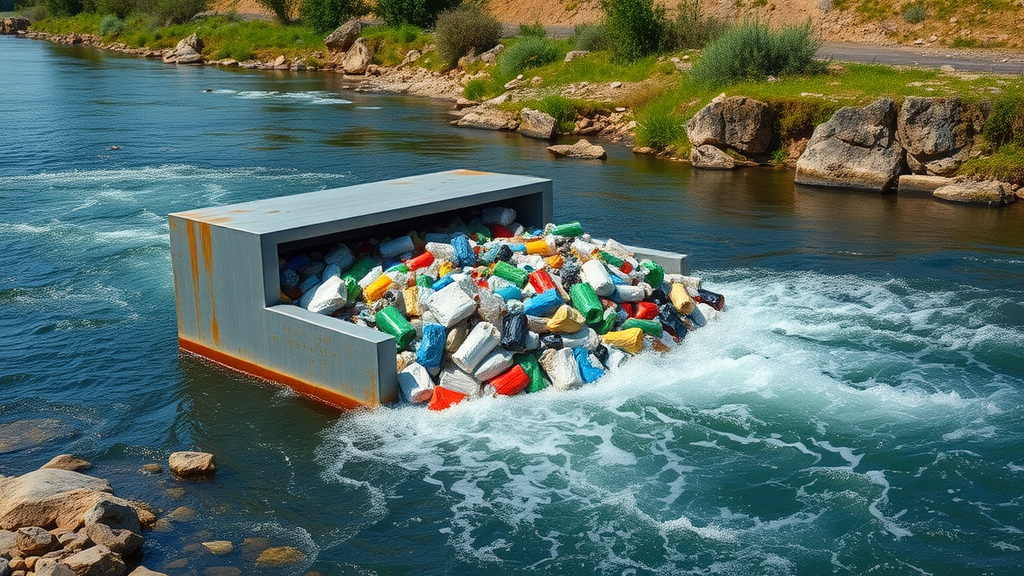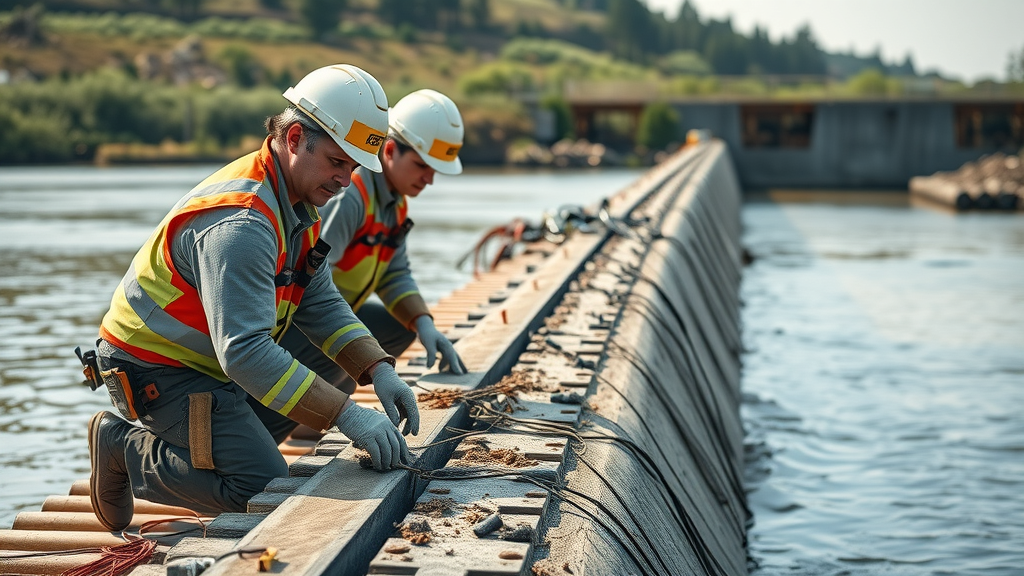Did you know that over 11 million metric tons of plastic waste flow into oceans every year, turning rivers into conveyor belts delivering oceans of plastic to the sea? This staggering statistic paints a sobering picture of the world’s battle with plastic pollution—and spotlights the urgent need for swift, effective interceptor barrier solutions. As our planet faces an unprecedented crisis of ocean plastic, innovative interceptor barriers have emerged as an essential defense, capturing plastic waste before it can reach and contaminate larger bodies of water. This opinion-focused guide uncovers how you can tackle interceptor barrier challenges quickly and help strengthen global ocean cleanup operations.
A Shocking Reality: Interceptor Barriers and the Fight Against Ocean Plastic
The scope of plastic pollution is truly breathtaking: every minute, the equivalent of one garbage truck’s worth of plastic enters the oceans. These oceans of plastic are not only catastrophic for marine life, but threaten entire food chains and human communities worldwide. Interceptor barrier systems have become the frontline guardians in this fight, aiming to capture plastic waste at river mouths—before it has a chance to enter the ocean and become part of sprawling ocean plastic gyres like the infamous Great Pacific Garbage Patch. As ocean clean technologies evolve, the focus shifts to how quickly and efficiently we can deploy, maintain, and innovate around these interceptor barriers for real, measurable impact on ocean cleanup.
But, as awareness grows, so too do the challenges. From deployment in heavily polluted rivers to maintenance and environmental compatibility, interceptor barrier solutions face an uphill battle. The world demands faster, better answers—and that’s exactly what this article will deliver.

What You'll Learn About Interceptor Barrier Solutions
- How interceptor barriers work to stop ocean plastic pollution
- The main challenges facing interceptor barrier deployment
- Insights into innovations for ocean cleanup
- Opinion on the most promising interceptor solutions
- Cost, maintenance, and the real-world impact of interceptor barriers
Understanding the Interceptor Barrier: The Core Technology for Ocean Clean
To truly understand the battle against oceans of plastic, you have to start with the interceptor barrier—the linchpin technology for any serious ocean clean operation. At its core, an interceptor barrier is a floating barricade system designed to capture a wide range of plastic waste flowing through rivers before it can reach open waters. Utilizing a combination of floating booms, mechanical collection arms, and conveyor belts, modern interceptor solutions like the Interceptor Original and Interceptor Tender are engineered to function autonomously in volatile, high-traffic waterways. Thanks to these innovations, ocean cleanup now begins upstream, recognizing that rivers are the source of nearly 80% of marine plastic pollution.
The genius behind the interceptor barrier is its ability to intercept not only small debris but also bulky objects, gathering everything into a centralized storage area for easy removal and proper waste management. This strategic collection method—often powered by renewable energy—minimizes human risk and operational costs. In the broader context of plastic pollution and river cleanup, the effectiveness of the interceptor barrier is matched only by its adaptability to local water currents, seasonality, and volumes of inflowing trash. Comparing the impact of such devices with traditional manual methods makes the essential role of interceptor barriers in modern ocean clean missions abundantly clear.

| Technology | Main Features | Effectiveness | Best Use Case | Cost Range |
|---|---|---|---|---|
| Interceptor Original | Autonomous, solar-powered conveyor Up to 50,000 kg/day collection |
High (urban rivers) | Large, high-flow rivers near cities | $750,000–$1,200,000 |
| Interceptor Tender | Hybrid-manned/robotic Adaptable to changing river depths |
Medium to High | Volatile river systems | $500,000–$950,000 |
| Floating Barrier Network | Low-tech, manual emptying Passive capture |
Medium (low-current rivers) | Small rivers, preliminary deployment | $100,000–$350,000 |
| AI-Powered Smart Barrier (Prototype) | Machine-vision sorting Data-driven optimization |
Emerging (trials ongoing) | Smart cities, research sites | $1,100,000–$2,000,000 |
Common Interceptor Barrier Challenges and Why They Matter
- Deployment issues in polluting rivers
- Plastic waste accumulation and maintenance
- Compatibility with various interceptor solutions
- Environmental impact on aquatic ecosystems
- Public and regulatory concerns
Despite their promise, interceptor barriers face several persistent challenges in achieving large-scale ocean clean results. First, deployment in polluting rivers is often hampered by variable currents, excessive debris, and unpredictable urban waste flows. These harsh environments can damage infrastructure or reduce the efficiency of interceptor barricade systems, sometimes overwhelming even the best-designed solutions. Second, the required frequency and cost of plastic waste accumulation and maintenance present real financial and logistical obstacles, especially for emerging economies or NGOs running river cleanups.
Furthermore, compatibility with other interceptor solutions can become an issue as no two polluting rivers are identical; different geographies and waste profiles demand uniquely flexible technologies. The environmental impact on aquatic ecosystems—though generally positive—must be carefully managed, ensuring no harm comes to wildlife through improper installation or operation. Finally, public and regulatory concerns—ranging from aesthetic objections to strict environmental review processes—can affect timelines and adoption rates, making open dialogue and scientific transparency crucial for ongoing success.
“The real battle is not just collecting plastic, but ensuring our solutions adapt to local urban and natural environments.” – Environmental Expert
My Opinion: Interceptor Barriers are the Linchpin of Successful Ocean Cleanup
In my informed view, no strategy for global ocean clean objectives is complete without the widespread deployment of the interceptor barrier. Despite ongoing ocean plastic and plastic pollution crises, these barriers provide a proven, scalable defense, capturing the bulk of plastic waste before it can enter the open ocean. While upstream waste reduction and global behavioral change are critical, there’s no substitute for targeted intervention at the critical bottleneck: our rivers. When paired with innovation—leveraging both interceptor original and interceptor tender models—the interceptor barrier embodies a pragmatic, actionable cornerstone for ocean cleanup progress. The sooner we solve their real-world challenges, the sooner we achieve sustainable, meaningful reductions in oceans of plastic.
Innovative Approaches to Interceptor Barrier Problems
- Adaptive interceptor original designs for volatile river currents
- Hybrid interceptor tender strategies
- Leveraging interceptor solution tech advancements
- Collaborative ocean cleanup frameworks
Modern innovation is rapidly reshaping the field. Adaptable interceptor original designs now employ modular structures and specialized anchoring systems for rivers with unpredictable flows. Hybrid interceptor tender approaches blend automation with hands-on support, ensuring quick response during flood events or unexpected debris surges. The integration of high-resolution cameras, remote monitoring, and AI-driven analytics allows interceptor solutions to optimize capture efficiency and predict maintenance needs before failures can occur. Importantly, global ocean cleanup success stories increasingly rely on partnerships—NGOs, local governments, and technology providers working together—because no single solution can solve the plastic crisis alone. The future belongs to those who innovate fast and share knowledge freely.
Case Studies: Success Stories Using the Interceptor Barrier
Across the globe, high-impact projects have underscored the immense value of interceptor barrier deployment. Take, for example, the Dominican Republic, where rivers notorious for transporting trash into the Caribbean were outfitted with advanced interceptor solutions. Within months, local volunteers reported reductions measured in millions of kilograms of plastic waste no longer entering the sea. Elsewhere, Southeast Asian cities—once ranked among the top contributors to ocean plastic pollution—have hailed the presence of interceptor barriers as transformative for community health and maritime industry sustainability.
What these successes share is rigorous data collection, frequent maintenance, and meaningful community engagement. Projects in Indonesia and Vietnam, for instance, have shown that when residents are trained to support river cleanup and waste separation at the source, the effectiveness of interceptor barriers more than doubles compared to standalone deployments. In each scenario, the reduction in oceans of plastic is not just visible, but community pride and environmental stewardship also increase—a dual win for people and the planet.

Cost Analysis: How Much Does the Interceptor Barrier Cost?
Investing in interceptor barrier systems requires careful financial planning. The capital and operational expenditures vary significantly depending on river size, technology choice, and local labor costs. For example, mass-produced Interceptor Original models—designed for series production—can cost between $750,000 and $1.2 million for initial install, although innovative financing and public-private partnerships are bringing costs down yearly. Contrast this with floating barrier networks—simple, low-tech solutions costing just $100,000 to $350,000, effective in smaller or slower rivers.
Operational costs generally account for waste removal, routine maintenance, and long-term component replacement. Compared to ocean-based cleanup systems—which require expensive ships and deal with diluted plastic debris in open water—river-based interceptor barriers boast much higher removal efficiency and a superior cost-per-kilogram ratio. Factoring in economic, environmental, and social returns, these barriers represent one of the most cost-effective ocean clean investments available today.
| Solution | One-Time Setup | Annual Operating | Cost/Kg Removed | Efficiency (%) |
|---|---|---|---|---|
| Interceptor Original | $1,000,000 | $125,000 | $0.10–$0.23 | 75–80 |
| Interceptor Tender | $850,000 | $100,000 | $0.15–$0.28 | 70–78 |
| Open Ocean Cleanup Ship | $4,500,000 | $600,000 | $2.40–$3.70 | 25–30 |
| Floating Barrier | $250,000 | $50,000 | $0.30–$0.65 | 50–58 |
Environmental and Social Impacts of the Interceptor Barrier
- Positive outcomes for ocean plastic and maritime communities
- Addressing the threat of plastic pollution
- Mitigating the impact on local wildlife
The ripple effects of a well-placed interceptor barrier are profound. Communities report improved fisheries, cleaner water, and revitalized tourism due to reduced flows of plastic debris. The social impact goes beyond environmental health: children and adults alike reconnect with formerly polluted waterways, building civic pride and environmental stewardship. Scientifically, studies show a dramatic reduction in local species deaths and entanglements with plastic waste. When managed responsibly, barriers have proven to be safe for aquatic life, especially when installed with wildlife bypasses and frequent monitoring. Tackling plastic pollution is as much a social enterprise as a technological one—with interceptor barriers serving as visible symbols of collective progress.

Expert Opinions: Can Interceptor Barriers Alone Solve Ocean Plastic Pollution?
“While interceptor barriers are a vital tool, they must be part of a coordinated, global strategy to reduce plastic waste at its source.” – Ocean Cleanup Specialist
A growing consensus among ocean cleanup experts is clear: while interceptor barriers play a crucial role, they are not a silver bullet for ocean plastic pollution. Their power is greatest when combined with upstream waste management programs, public education, and corporate responsibility initiatives that target the root causes of trash entering our rivers. The future of a cleaner ocean will depend on both technological solutions—like the interceptor barrier—and the collective resolve to reduce single-use plastics and improve recycling worldwide.
Deep Dive: The Purpose of an Interceptor in Plastic Waste Management
The fundamental goal of any interceptor barrier is prevention. By intercepting plastic debris in polluting river hotspots, these systems halt tens of thousands of tons of waste that would otherwise enter the oceans of plastic. Case studies demonstrate that places with early and robust interceptor deployments have achieved a significant drop in plastic load downstream. This not only relieves pressure on beaches and marine life but also reduces the resources spent on open-sea cleanups and the environmental damage from microplastics and garbage patches forming in the open ocean. With strategic planning and ongoing support, the “interceptor effect” can become the gold standard for upstream plastic waste management.
Imagine a fast-flowing, muddy river after heavy rains—laden with urban trash and organic debris. In these high-stress scenarios, video demonstrations of the interceptor barrier in action reveal its remarkable effectiveness: floating arms guide trash toward onboard conveyors, where plastic and other floating waste are efficiently separated and stored—even during minor floods or monsoon surges. The system’s real-time monitoring and automatic shutoff help safeguard both the barrier and aquatic life during dangerous conditions, demonstrating the reliability of interceptor solutions in the world’s most challenging polluting rivers.
Video walkthrough demonstrating deployment and operation of interceptor barriers during high river flows and floods, showing real plastic waste capture in challenging conditions.
Overcoming Maintenance & Durability Issues for Interceptor Barriers
- Routine maintenance procedures
- Latest materials enhancing durability
- Learning from interceptor original and interceptor tender prototypes
Maintenance is crucial for the ongoing performance of every interceptor barrier. Leading ocean clean organizations now rely on scheduled checks, rapid-response teams, and modular part swaps to minimize downtime. The latest barriers are built from corrosion-resistant alloys and self-healing polymers, designed to handle years of abrasion, UV exposure, and impacts from logs or boats. By studying failure points in interceptor original and interceptor tender models, engineers have dramatically increased lifespan and reduced service frequency. Combined with digital sensors for real-time diagnostics, today’s interceptor solutions are more robust—and more flexible—than ever before.

See for yourself how a modern interceptor barrier solution is installed in a high-pollution area: the process starts with location scouting and river-flow mapping, followed by the deployment of anchoring points and careful assembly of floating arms and conveyor units. The step-by-step guide captures each part of the process, highlighting safety protocols and calibration. Once complete, sensors and cameras begin monitoring plastic in real time, and the conveyor system rigorously collects debris, demonstrating the full scope of what’s possible for ocean clean efforts at the river level.
People Also Ask: Interceptor Barrier in Ocean Clean Efforts
How does the interceptor barrier work?
An interceptor barrier operates by floating laterally across a river, using angled arms to funnel plastic debris and other floating trash into a central collection zone. Once captured, debris is lifted via a conveyor belt and sorted into containers for recycling or disposal. The process is fully automated on some models, such as the Interceptor Original, and combines passive water flow with active mechanical capture. These systems are positioned where the flow and volume of plastic are highest—near urban centers or at key river outflows—ensuring the most significant impact in stopping plastic waste before it can enter the ocean.
What is the purpose of an interceptor?
The principal purpose of an interceptor barrier is to prevent ocean plastic pollution by intercepting and removing plastic waste from rivers—the main transport channels for ocean-bound debris. This strategy supports a larger, comprehensive ocean cleanup approach by reducing the volume of plastic reaching the ocean, alleviating the burden on marine cleanups and protecting ecosystems from further damage. In this way, interceptor barriers are a key first step in a multi-tiered approach to tackling the world’s oceans of plastic.
Why don't they clean up the Great Pacific Garbage Patch?
Cleaning up areas like the Great Pacific Garbage Patch is extremely challenging due to the vast scale, harsh conditions, and diffuse nature of microplastics and floating debris. As a result, ocean cleanup organizations prioritize upstream intervention—using interceptor barrier solutions in rivers and coastal areas to stop new plastic from ever reaching ocean gyres. This approach not only proves more efficient in terms of cost per kilogram of waste removed but also addresses the root of the problem, preventing future garbage patches from forming and making open-sea efforts more manageable in the long run.
How much does the interceptor barrier cost?
The cost of a modern interceptor barrier system typically ranges from $750,000 to $1.2 million for capital expenditure, with annual operating costs between $100,000 and $125,000. These figures vary based on river size, access, and technological upgrades. Compared with open ocean cleanup ships—which can exceed $4.5 million in startup costs alone—interceptor barriers offer a more affordable and high-impact alternative for targeting plastic pollution at the source.
Latest Interceptor Solutions and Future Trends in Ocean Cleanup
- AI-driven interceptor solutions improving capture rates
- Integration with global plastic waste monitoring systems
- Moves toward fully automated ocean clean infrastructure
The future of ocean clean lies in automation and intelligence. Recent breakthroughs include AI-driven interceptor solutions that utilize camera and sensor data to identify, track, and sort different types of debris, optimizing removal in real time. Global monitoring systems connect barriers to satellite and drone feeds, allowing operators to predict trash surges and preemptively redirect resources. Fully automated “smart” barriers, now in advanced development, promise to eliminate nearly all manual oversight—heralding an era of round-the-clock, self-sustained river cleanup. The ultimate goal: a global web of interconnected barriers systematically shutting down the ever-growing flow of plastic waste into our oceans.

Key Takeaways: What Matters Most for Interceptor Barrier Success
- Effective placement and ongoing innovation are critical for long-term impact
- Collaboration between public, private, and NGO sectors enhances mission outcomes
- Continued monitoring and iteration are essential for plastic pollution control
FAQs: Everything You Need to Know About Interceptor Barriers
-
How are interceptor barriers maintained?
Maintenance teams conduct regular inspections, clear accumulated debris, monitor moving parts, and use digital diagnostics to spot early issues. This keeps barriers running efficiently in various conditions. -
Can interceptor barriers be used in all river types?
Most interceptor barriers are designed for flexible deployment, but extreme currents, fluctuating water levels, or narrow channel widths may require custom solutions or other river cleanup strategies. -
What are the risks to marine life?
Properly designed barriers include wildlife bypasses and use non-invasive collection techniques, minimizing the risk to local fish and aquatic fauna. Continuous monitoring further reduces ecological impact. -
How do interceptor barriers fit into broader ocean cleanup initiatives?
Interceptor barriers serve as the initial “capture” point within a holistic waste management and ocean cleanup network, working alongside education, policy, and extended producer responsibility to deliver sustainable results.
Conclusion: The Path Ahead for Interceptor Barrier Innovation
Interceptor barriers are essential for scalable ocean clean and ocean cleanup—now is the time to drive innovation, policy support, and community action to ensure a future free from oceans of plastic.
To enhance your understanding of interceptor barriers and their role in combating plastic pollution, consider exploring the following resources:
-
“Solar-powered barge a key ‘interceptor’ for plastic waste”: This article details the deployment of a solar-powered barge designed to intercept and remove plastic waste from rivers before it reaches the ocean. It highlights the barge’s capabilities, including its ability to collect up to 50 tons of waste daily, and discusses its implementation in Malaysia’s Klang River. (phys.org)
-
“In L.A., this sleek barrier kept 35,000 pounds of trash out of the ocean”: This piece examines the effectiveness of an interceptor barrier installed in Los Angeles, which successfully prevented 35,000 pounds of trash from entering the ocean. It provides insights into the barrier’s design, operation, and the broader implications for urban waste management. (fastcompany.com)
These articles offer valuable perspectives on the practical applications and successes of interceptor barriers in various environments. If you’re committed to addressing plastic pollution, these resources will provide you with actionable insights and real-world examples of effective solutions.
 Add Row
Add Row  Add
Add 




Write A Comment